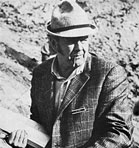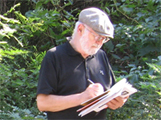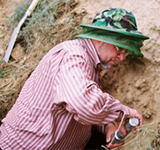About Us - Historical Review
History of the INQUA Loess Commission 1961/69 – 2003
by Ian J. Smalley
 At the 6th INQUA Congress in Poland in 1961 the INQUA Sub-Commission of European Loess Stratigraphy came into being as a specialist group operating within the remit of the Stratigraphy Commission. This initiative was due to Julius Fink of the University of Vienna and it was his vision of loess research in Europe which provided the structure and drove forward the activities of the sub-commission in the early days. In fact it was Fink’s vision which carried the Loess Commission through its entire 40 year existence. At the 8th INQUA Congress in Paris in 1969 the Sub-Commission was upgraded to full Commission status, and by then the programe was settled and a considerable amount of activity had occurred. The aim was to study loess stratigraphy all across Europe, and to develop continent wide correlations. This would be assisted by annual meetings in the various participating countries, and by the preparation of the INQUA Loess Map of Europe. Also there was the general belief that the study of loess could add to the better understanding of the Quaternary period. The map project was to be overseen by Gunter Haase of the Academy of Sciences in Leipzig.
At the 6th INQUA Congress in Poland in 1961 the INQUA Sub-Commission of European Loess Stratigraphy came into being as a specialist group operating within the remit of the Stratigraphy Commission. This initiative was due to Julius Fink of the University of Vienna and it was his vision of loess research in Europe which provided the structure and drove forward the activities of the sub-commission in the early days. In fact it was Fink’s vision which carried the Loess Commission through its entire 40 year existence. At the 8th INQUA Congress in Paris in 1969 the Sub-Commission was upgraded to full Commission status, and by then the programe was settled and a considerable amount of activity had occurred. The aim was to study loess stratigraphy all across Europe, and to develop continent wide correlations. This would be assisted by annual meetings in the various participating countries, and by the preparation of the INQUA Loess Map of Europe. Also there was the general belief that the study of loess could add to the better understanding of the Quaternary period. The map project was to be overseen by Gunter Haase of the Academy of Sciences in Leipzig.
One early event from the Sub-Commission period needs to be recorded. During the 1961 Congress in Poland there was a Loess Symposium, held in Lublin, at which eleven papers were presented. One of these was presented by Liu Tung-sheng of Academia Sinica and was the first demonstration, to an international audience, of the marvellous complexity of the loess record in China. Fink had arranged for Liu to attend the Congress and the result was one of the most important papers in the history of Quaternary science. Suddenly the Quaternary became a much more complex and interesting place and loess stratigraphy was instantly placed at the heart of palaeoclimatology. So the Loess Sub-Commission started in a very auspicious manner.
 Marton Pecsi of the Hungarian Academy of Sciences took over the presidency of the Commission in 1977. He, building on the successful base established by Fink, introduced two major significant advances. He extended the scope of the Commission; from being just European it became worldwide; and he encouraged research on applied and engineering topics- such as soil erosion and building subsidence. Pecsi was a serious loess enthusiast and the Commission flourished under his direction. Possibly the major occurrence during his presidency was the establishment, at the 1977(10th) Birmingham INQUA Congress, of the Western Pacific Working Group. This was the initiative of Jim Bowler of the Australian National University and it aimed to bring together students of loess in Australia, New Zealand and China- the Western Pacific Region. The structure of the WPWG was set up in 1979, in Auckland at the annual meeting of the Australia & New Zealand Association for the Advancement of Science. It was agreed that Bowler would initiate three fields trips, in the three participating countries, and Ian Smalley, from the Department of Scientific and Industrial Research in Wellington would start a newsletter. The three field trips were very successful and the newsletter became Loess Letter- which continues to serve the loess community. The first seven issues of LL were published by DSIR and then the journal moved to Canada. Issues 8-16 were published by the University of Waterloo; then a move to England. Issues 17-34 were published by Leicester University, and 35 onwards by Nottingham Trent University.
Marton Pecsi of the Hungarian Academy of Sciences took over the presidency of the Commission in 1977. He, building on the successful base established by Fink, introduced two major significant advances. He extended the scope of the Commission; from being just European it became worldwide; and he encouraged research on applied and engineering topics- such as soil erosion and building subsidence. Pecsi was a serious loess enthusiast and the Commission flourished under his direction. Possibly the major occurrence during his presidency was the establishment, at the 1977(10th) Birmingham INQUA Congress, of the Western Pacific Working Group. This was the initiative of Jim Bowler of the Australian National University and it aimed to bring together students of loess in Australia, New Zealand and China- the Western Pacific Region. The structure of the WPWG was set up in 1979, in Auckland at the annual meeting of the Australia & New Zealand Association for the Advancement of Science. It was agreed that Bowler would initiate three fields trips, in the three participating countries, and Ian Smalley, from the Department of Scientific and Industrial Research in Wellington would start a newsletter. The three field trips were very successful and the newsletter became Loess Letter- which continues to serve the loess community. The first seven issues of LL were published by DSIR and then the journal moved to Canada. Issues 8-16 were published by the University of Waterloo; then a move to England. Issues 17-34 were published by Leicester University, and 35 onwards by Nottingham Trent University.
 Pecsi handed the presidency over to An Zhi-sheng of Academia Sinica in 1991 at the Beijing(13th) INQUA Congress. This Beijing Congress was a highpoint for the Loess Commission because of the setting in the country of the loess- one day field trips available to the type section of the Malan loess- and the demonstration of the huge growth of interest in all aspects of loess study. An’s role as president was to continue the internationalization started by Pecsi and to bring together the activities of the Commission and the great loess resources of China. The Beijing Congress was a grand loess event with over 250 papers devoted to loessic topics.
Pecsi handed the presidency over to An Zhi-sheng of Academia Sinica in 1991 at the Beijing(13th) INQUA Congress. This Beijing Congress was a highpoint for the Loess Commission because of the setting in the country of the loess- one day field trips available to the type section of the Malan loess- and the demonstration of the huge growth of interest in all aspects of loess study. An’s role as president was to continue the internationalization started by Pecsi and to bring together the activities of the Commission and the great loess resources of China. The Beijing Congress was a grand loess event with over 250 papers devoted to loessic topics.

 An’s presidency started with a noteable event and ended with another. In 1999, largely at the behest of Ludwig Zoeller, a great LoessFest was held in Heidelberg and Bonn. This was, in effect, the climax of Loess Commission activities. The purpose was to celebrate the 175th anniversary of the naming of the ‘loess’ by Karl Caesar von Leonhard in Heidelberg at the beginning of the nineteenth century. The LoessFest, like the story of European loess, opened at the Haarlass section in Heidelberg- and progressed from there. By 1999 there was a vast international loess literature and a wide range of active research topics and regions. Later in 1999, at the Berlin INQUA Congress An handed over to Ian Smalley who presided over the shutting down of the Commission up to its demise (along with all the other INQUA Commissions) in the great INQUA re-organisation of 2003.
An’s presidency started with a noteable event and ended with another. In 1999, largely at the behest of Ludwig Zoeller, a great LoessFest was held in Heidelberg and Bonn. This was, in effect, the climax of Loess Commission activities. The purpose was to celebrate the 175th anniversary of the naming of the ‘loess’ by Karl Caesar von Leonhard in Heidelberg at the beginning of the nineteenth century. The LoessFest, like the story of European loess, opened at the Haarlass section in Heidelberg- and progressed from there. By 1999 there was a vast international loess literature and a wide range of active research topics and regions. Later in 1999, at the Berlin INQUA Congress An handed over to Ian Smalley who presided over the shutting down of the Commission up to its demise (along with all the other INQUA Commissions) in the great INQUA re-organisation of 2003.
From 2003 to 2011 the first president of re-established Loess subcommission and later Loess Focus Group was Ludwig Zoeller.
Very interesting article about this organisation entitled "The INQUA Loess Commission as a Central European Enterprise" was published by Central European Journal of Geosciences in 2010 (authors: Ian J. Smalley, Slobodan B. Markovic and Ken O’Hara-Dhand).
You can download the full paper here »

